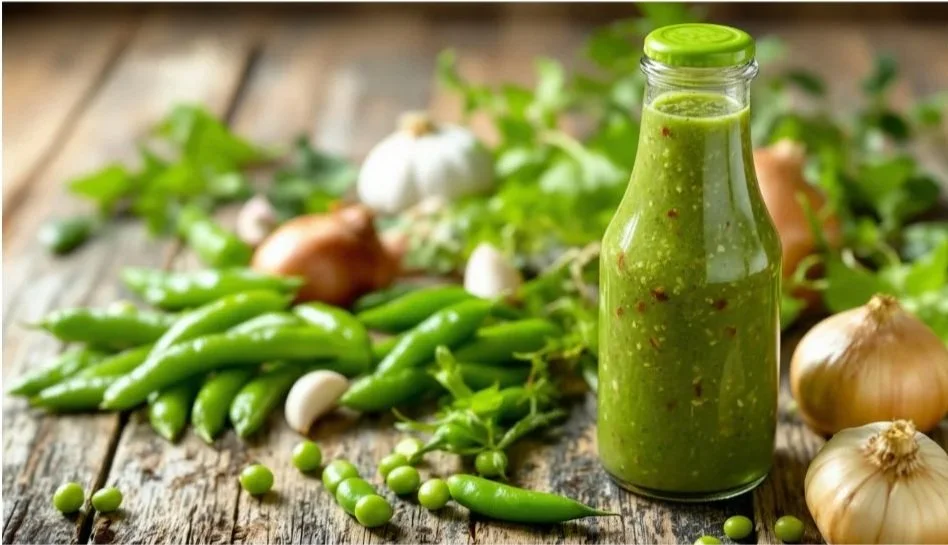Fermented Green Heat: A Unique Hot Sauce with Peas, Green Chillies, Garlic & Onions
If you love the funky complexity of fermented foods and the bright kick of a homemade hot sauce, you’re going to love this recipe. Today, we’re taking a slightly unconventional path by using green peas as the creamy, subtly sweet backbone of a vibrant fermented green chilli hot sauce. Paired with garlic, onions, and fresh chillies, this sauce brings together heat, sweetness, and tang in a beautifully balanced way.
Whether you’re new to fermentation or already obsessed (like me), this is an approachable and deeply rewarding project that delivers bold flavor—and keeps getting better with time.
Why Ferment Hot Sauce?
Fermentation does more than just preserve your ingredients. It transforms them.
Flavor depth: Fermentation softens harsh edges and creates natural umami.
Probiotic goodness: A living sauce supporting gut health.
Customizable heat & acidity: You choose how spicy, funky, or tangy your final sauce becomes.
Long shelf life: When stored properly, fermented hot sauces can last months.
Peas might seem unusual, but they add body and subtle sweetness—balancing the punch of the green chillies.
Ingredients
For a 500–750 ml batch:
1 cup fresh or frozen peas
10–12 green chillies (adjust for heat preference)
5–6 cloves garlic
1 medium onion, roughly chopped
2 cups non-chlorinated water
1.5 tbsp sea salt (for ~3% brine)
Optional flavor boosters:
A squeeze of lime juice
A handful of fresh coriander
1 tsp sugar or honey (for roundness, post-fermentation
1. Prepare the brine
Dissolve the sea salt in the water. Taste—it should be pleasantly salty, like the sea.
2. Prep your vegetables
Remove stems from the chillies. Roughly chop chillies, onion, and garlic. If using frozen peas, no need to thaw.
3. Pack the jar
In a sterilized wide-mouth jar, add peas, chillies, garlic, and onion.
Pour the brine over until everything is submerged.
Important: Keep all vegetables below the brine to avoid mold.
Use a fermentation weight, a smaller jar, or even a clean stone.
4. Ferment
Cover with a fermentation lid or a loose jar lid (to allow gas release).
Leave at room temperature (18–22°C) for 5–10 days.
Bubbles = good.
Cloudy brine = normal.
White harmless yeast (kahm yeast) = fine, skim it.
Fuzzy mold = not fine → discard.
Taste after day 5. Once the flavor is tangy with a bit of funk, it’s ready.
5. Blend into Hot Sauce
Strain the mixture (but save the brine!).
Blend all the solids until smooth, adding brine bit by bit until you reach your desired consistency.
For extra brightness, blend in:
a splash of vinegar or lime juice
a small handful of fresh herbs
Taste and adjust: more acidity, a touch of salt, or a whisper of sweetness.
6. Bottle & Store
Transfer the sauce to a clean bottle or jar.
Because it’s fermented and alive, keep it in the fridge.
The flavor will continue evolving for weeks—often getting smoother and more rounded.
How to Use This Green Fermented Hot Sauce
This sauce is incredibly versatile:
Drizzle over grilled chicken or fish
Add a spoonful to ramen or noodle bowls
Splash onto tacos or quesadillas
Mix with mayo or yogurt for a creamy spicy dip
Stir into dressings for a tangy heat hit
Spread on sandwiches or smash burgers for a herbal zing
The peas give it a velvety texture, while the fermented chillies and garlic deliver bright, earthy heat. It’s addictive.
Final Thoughts
Fermenting hot sauce may sound intimidating, but it’s truly a low-effort, high-reward kitchen project. With simple ingredients and a bit of time, you’ll create a sauce richer and more complex than anything in a store.
If you try this recipe, I’d love to help you customize it—want it smokier? Sweeter? Spicier? Just ask!

